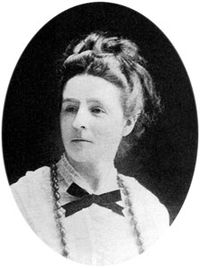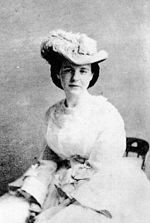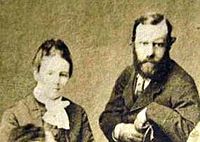- Martha Bulloch Roosevelt
-
Martha Bulloch 
Martha Bulloch RooseveltBorn July 8, 1835
Hartford, ConnecticutDied February 14, 1884 (aged 48)
New York, New YorkOccupation Socialite Spouse Theodore Roosevelt, Sr. Children Anna Roosevelt
Theodore Roosevelt
Elliott Roosevelt
Corinne RooseveltParents James Stephens Bulloch and Martha (Stewart) Elliott Martha Bulloch Roosevelt (July 8, 1835 – February 14, 1884) was the mother of US President Theodore Roosevelt and the paternal grandmother of Eleanor Roosevelt. She married Theodore Roosevelt, Sr., and had four children. She was a descendant of Archibald Bulloch. A true southern belle, she was affectionately known as Mittie, and is thought to have been one of the inspirations for Scarlett O'Hara.[1]
Contents
Childhood
Martha was born in Hartford, Connecticut on July 8, 1835, to Major James Stephens Bulloch and Martha (Stewart) Elliott Bulloch; the family had traveled north with Mittie's older brother, James Dunwody Bulloch, who was studying with tutors in preparation for boarding school. After a few months in Hartford, baby Mittie and her mother returned to their home in Savannah, Georgia.[2]
When Mittie was four, Major Bulloch moved the family to Cobb County, Georgia and the new village that would become Roswell, Georgia. It lies just north of the Chattahoochee River and the city of Atlanta, Georgia, and Major Bulloch had gone there to become a partner in a new cotton mill with Roswell King, the town's founder. Bulloch had a mansion built, and soon after it was completed in 1839, the family moved into Bulloch Hall. As a significant antebellum structure, it has been listed on the National Register of Historic Places.
The Bullochs were a wealthy planter family, members of the Georgia elite. In 1850, they held thirty-one enslaved African-Americans, most of whom worked in their cotton fields.[3] Others were assigned to such domestic tasks as cooking, sewing, and related work. Recent research in Bulloch records identified 33 slaves who were owned by the family. They have been commemorated on a plaque on the mansion grounds.[4]
During the time that Mittie's family occupied Bulloch Hall, maintenance of the house and grounds depended on slave labor, a fact that her Roosevelt descendants would find "incredible" and, for the most part, avoid discussing. The evidence, however, is clear. Federal census takers in 1850 listed nineteen slaves at Bulloch Hall, including thirteen adults and six children.
Mittie, like all her siblings, was assigned a personal slave, or a "shadow," to act as companion. Mittie's companion, Lavinia, for example, went everywhere with her, stopping outside the classroom when Mittie went inside, and sleeping on a mat by her side at night. For the family, the stress was on the pleasure of the companionship rather than on the hostage implications in the arrangement or the grimmer side of slavery.
After Major Bulloch's death in 1849, the family's fortunes declined somewhat, but Mittie was given a grand wedding to Theodore Roosevelt, Sr. in 1853. Later, as was expected of young southern gentlemen, Mittie's brothers, James and Irvine, fought in the Civil War as Confederate officers. They both lived in England after the war.[2]
It is believed by some that the character of Scarlett O'Hara, in Margaret Mitchell's novel, Gone With the Wind, was based partly on Mittie.[1] (Another inspiration is said to have been Mitchell's own businesswoman grandmother.) Mittie was a true southern belle, a beautiful and spirited woman at her best, not unlike the fictional Scarlett. Mitchell had, in fact, interviewed Mittie's closest childhood friend and bridesmaid, Evelyn King, for a story in the Atlanta Journal newspaper in the early 1920s.[5] In that interview, Mittie's beauty, charm, and fun-loving nature were described in detail.[1]
Marriage to Theodore Roosevelt, Sr.
Mittie married Theodore Roosevelt, Sr. on December 22, 1853 at the Greek Revival-style family mansion Bulloch Hall in Roswell; they were wedded in front of the pocket doors in the formal dining room. Before Theodore arrived in Georgia for the ceremony, she taunted him with the fact that she was receiving attention from other men. It was her right, she insisted, even as an engaged woman to dance with whomever she pleased. She even presumed to dictate his behavior, writing him careful instructions to arrive one day before the nuptials "and not a day sooner." Later it would be said that she possessed her own unique way of doing things, but even in her teens she showed a headstrong quality that set her apart from her contemporaries. For this occasion she had boasted to the bridegroom that she meant to show everyone in attendance how such celebrations should be staged.
Definitely the bride's party, this celebration drew guests from all over that part of Georgia but only a remarkably small contingent of Roosevelts. None of Theodore's four brothers or their families had made the trip south for the ceremony; only his parents, the severe Cornelius Van Schaack Roosevelt, a prosperous New York merchant, and his Philadelphia-born wife, Margaret Barnhill, represented the clan. This marked the first time either Margaret or Cornelius had ventured into the Deep South. Evelyn King sensed some discomfort on their part, and many years later, as the last surviving bridesmaid, she told a young reporter, then known as Peggy Mitchell but later famous as the author of Gone with the Wind, what she thought of the Roosevelts: "Like most northern people of that time, they were very ignorant about the South. Goodness only knows what they expected us to be like."
Immediately following the ceremony, the celebration began. The bride's family had been preparing for weeks, and now tables throughout Bulloch Hall displayed an array of hams, turkeys, and cakes, alongside a huge assortment of salads and pickled vegetables. Most dazzling of all, the "frozen cream" attracted a string of gawkers. Ice cream, known in England since the mid-1600s, had been introduced in the colonies around the time of the Revolution, and Dolley Madison served the delicacy at her husband's second inaugural ball in 1813. But places like Roswell, Georgia, where temperatures rarely fell to freezing, had less acquaintance with the cold, creamy dessert. For Mittie's wedding the ice had to be shipped in from the North, and then, using the newly invented ice cream freezer, servants cranked several gallons of cream, sugar, and flavorings into a luscious concoction in just a few minutes.
The festivities continued for one full week, and the guests who had traveled too far to return home each night were provided by the neighboring houses with sleeping space, although hours for sleeping were short. During the day, luncheons and teas kept the older guests busy while the young people walked and rode horses. In the evening, all ages mingled in dancing and storytelling that filled the houses with song and laughter. Mittie's brother Dan provided the music the day of the ceremony by playing his flute "in perfect time" and thus making an indelible impression on the staid Roosevelts. In the days following the reception, hired musicians joined in, rotating with each other and the guests until it became impossible to distinguish who among them had come to work and who to dance. After seven days of fun, the wedding finally ended. As Evelyn King told Margaret Mitchell many years later: "Everybody packed up and went home for it was all over and we were very tired." [6]
After their honeymoon, the couple moved into their new home at 28th East 20th Street, New York, a wedding present from Cornelius van Schaick (CVS) Roosevelt (Theodore's father). All four of CVS's sons lived near his own house at 14th Street and Broadway in Union Square. Shortly afterward, her mother, Martha, and sister, Anna Bulloch, moved north to join them in New York.
Mittie bore four children:
- Anna, nicknamed Bamie, (1855–1931)
- Theodore, nicknamed Teedie (T.D.), (1858–1919)
- Elliott, nicknamed Ellie, (1860–1893), the father of Eleanor Roosevelt
- Corinne, nicknamed Conie, (1861–1933), grandmother of Joseph and Stewart Alsop
Life After Roswell
During the war, Mittie was terrified for her brothers, James and Irvine. James was a confederate agent in Britain, and Irvine was the youngest officer on the CSS Alabama, firing the last gun before the ship sank in battle off the coast of Cherbourg, France. These emotional crises were mitigated somewhat by the maturity and management skills of Mittie's eldest daughter, Bamie, who stepped into a leadership role at a young age, especially when her father, "Thee," was out of town in Washington, visiting Lincoln and lobbying Congress for programs to support the northern troops in the field and their families back home. Thee, a Northerner himself, left his conflicted home situation to fight for the Union cause, acting as an Allotment Commissioner for New York and traveling to persuade soldiers to send a percentage of their wages to their families.
During her children's education, the family traveled to Europe, predominantly spending time in England, France, Switzerland, Italy, Austria, and Germany from May 1869 to May 1870. And then on a second trip, an extended boat trip down the Nile, a trip through the Holy Land, and on to Vienna, Germany and France from October 1872 to November 1873. On this second tour, Theodore Sr. returned to America to go back to work and oversee the building of the new family home at Number 6 West 57th Street. The three youngest children stayed in Dresden while Mittie and Bamie went to Paris and then the spa at Carlsbad so Mittie could restore her health.
Death
Martha Roosevelt died of typhoid fever on February 14, 1884, aged forty-eight, on the same day and in the same house as her son Theodore's first wife, Alice Lee Roosevelt, who died of Bright's disease, and two days after the birth of her granddaughter Alice Roosevelt Longworth. She is buried at Green-Wood Cemetery located in Brooklyn, New York.
Mittie described in Theodore Roosevelt's Autobiography
Theodore Roosevelt, in his autobiography published in 1913, described his mother with these words, "My mother, Martha Bulloch, was a sweet, gracious, beautiful Southern woman, a delightful companion and beloved by everybody. She was entirely 'unreconstructed' (sympathetic to the Southern Confederate cause) to the day of her death."[7]
Gallery
-
Bulloch Hall, the quintessential antebellum home of the South, is where Mittie grew up and was married.
-
The fireplace mantle in the room where Theodore Roosevelt, Sr. and Mittie Bulloch were married.
See also
- James Dunwoody Bulloch, half-brother
- Irvine Bulloch, brother
- Theodore Roosevelt, son
- Eleanor Roosevelt, granddaughter
- Alice Hathaway Lee Roosevelt, daughter-in-law
- Alice Lee Roosevelt Longworth, granddaughter
- Anna Roosevelt Halsted, great-granddaughter
- Franklin D. Roosevelt, Jr. great-grandson
Sources
Primary sources
- Roosevelt, Theodore. An Autobiography. (1913)
Secondary sources
- Beale Howard K. Theodore Roosevelt and the Rise of America to World Power (1956).
- Brands, H.W. Theodore Roosevelt (2001)
- Dalton, Kathleen. Theodore Roosevelt: A Strenuous Life. (2002)
- Harbaugh, William Henry. The Life and Times of Theodore Roosevelt. (1963)
- McCullouch, David. Mornings on Horseback, The Story of an Extraordinary Family, a Vanished Way of Life, and the Unique Child Who Became Theodore Roosevelt (2001)
- Morris, Edmund The Rise of Theodore Roosevelt (1979)
- Morris, Edmund Theodore Rex. (2001)
- Mowry, George. The era of Theodore Roosevelt and the birth of modern America, 1900–1912. (1954)
References
- ^ a b c McCullouch, p.47.
- ^ a b http://www.theodoreroosevelt.org/life/familytree/Mittie.htm
- ^ http://ftp.rootsweb.com/pub/usgenweb/ga/cobb/census/1850/1850slaveschedules
- ^ http://www.bullochhall.org/permanentexhibits.asp
- ^ Mitchell, Peggy. – Atlanta Journal. – June 10, 1923
- ^ http://www.electricscotland.com/history/women/wh50.htm
- ^ http://www.bartleby.com/55/
External links
Categories:- 1835 births
- 1884 deaths
- Bulloch family
- Deaths from typhoid fever
- Parents of Presidents of the United States
- People from Hartford, Connecticut
- Roosevelt family
- People from Roswell, Georgia
- American people of Scotch-Irish descent
- American people of Scottish descent
- Infectious disease deaths in New York
Wikimedia Foundation. 2010.






